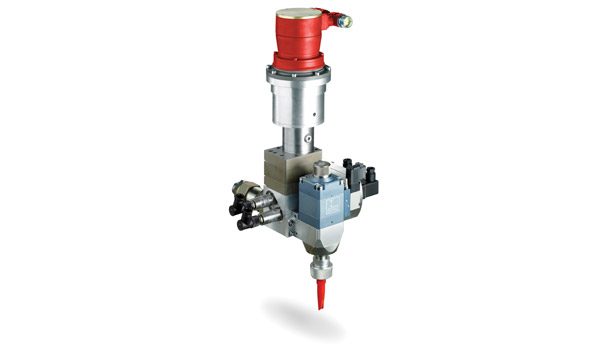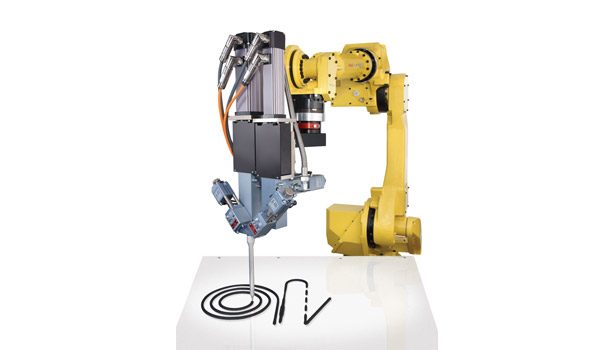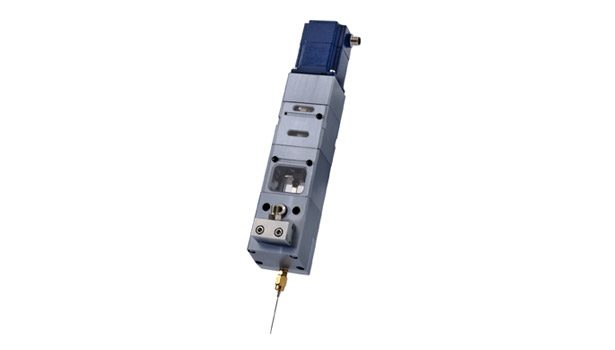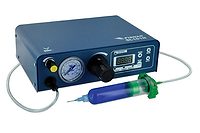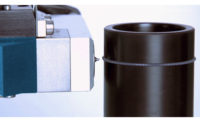As the market continues to push the production of lighter, stronger, and more chemical-resistant epoxies, polyurethanes, and silicones, the importance of using
| Jump to: |
accurate metering and dispensing equipment grows as well. Over the past decade, metering precision has reached levels that were previously thought to be unobtainable. This is due in part to a better understanding of where errors in the metering process occur.
One of the areas found to be most problematic was hoses located downstream from the metering point. Hoses cause errors for many different reasons, but the underlying problem is the need to eliminate distance between the metering point and the dispensing point while remaining light and compact enough to be used in conjunction with a motion platform.
Metering and Dispensing Types
In the world of metering and dispensing, the two main application types can be broken down into several smaller groups. The first group to consider is shot or filling applications. In shot-dispensing scenarios, the main concern is the shot size, or dispensing volume. In addition, any time you are dealing with multi-component materials, maintaining the proper mix ratio is also important.
In shot applications, the smaller the required volume, the more difficult it becomes to dispense, and the more problems hoses can cause. Hose expansion, thixotropic materials and high viscosities can all lead to dispensing either too much or too little material. Metering small precision shots through lengthy hoses can prove to be nearly impossible because of hose expansion and material properties.
Precision bead laying is the second category of dispensing. Variable-speed bead laying has proven to be one of the most difficult applications because the dispensing machine must have the ability to speed up and slow down the dispensing rate during the cycle. Maintaining the proper output speed and mix ratio during these changes can be tricky with any length of hose after the metering point.
In order to combat these problems, many dispensing equipment manufacturers have started to shift their research and development departments to designing small, compact, lightweight, end-of-tool metering systems. The main advantage of these machines is that all of the metering is done right at the dispensing location. End-of-tool metering units are capable of staying within ± 1% of the desired mix ratio and output rate while remaining lightweight and compact enough to be fitted on the end of a robot or XYZ gantry in automated processes.
Single-Component Materials
In their simplest form, positive displacement metering valves are end-of-tool metering units for shot applications. Metering valves are most useful in applications requiring repeatable shots of a single-component material, such as epoxy or grease. Positive displacement metering valves are capable of metering between 0.001-100 cc. Each of these valves has a specific shot size range that is controlled by mechanical adjustment, which increases and decreases the size of the metering chamber inside the valve.
In their simplest form, positive displacement metering valves are end-of-tool metering units for shot applications. |
For larger dispensing volumes and variable speeds, bead laying gear pumps can be used in conjunction with volume counters to meter extremely precise shots and beads. Dispensing companies have been using this setup for years, but have had to use hoses to connect the metering unit to the outlet valve. Now, compact units have taken the gear pump and flow meter and mounted it directly to the outlet valve. Many of these types of units are compact and light enough to be mounted on a motion platform.
For many applications, gear metering pumps are the correct solution. However, materials containing abrasive fillers should not be processed with gear pumps. Abrasive fillers can grind the gears inside the pump, causing it to lose accuracy or stop working altogether. For abrasive materials, piston pumps are often the appropriate answer. Piston metering systems can incorporate diamond-like carbon-coated parts and upgraded seals for further abrasive resistance.
Some piston pump systems on the market today are small and light enough to be mounted on a motion platform as well. This is due, in part, to the use of servo motors. Servo motors are used not only because of their size and weight, but also because they allow the dispensing machine to easily link the dispensing speed and movement of the motion platform.
Multi-Component Materials
Metering multi-component materials through hoses is more complicated. Lead-lag issues, hose expansion, or materials that are thixotropic, highly viscous, have wide ratios, or have large viscosity differences between components are only a few problems stemming from long hoses. As always, small precision shots are the hardest to achieve. This has been accomplished by using small, servo-driven piston metering heads that can dispense as little as 0.02 cc of mixed material. Since these metering heads are servo driven, they are capable of laying down beads as well as dots. Servo motors also give the units the ability to be easily linked with a motion platform.
Designers had to be extra creative when it came to end-of-tool metering units for continuous flow applications. Double-acting, piston-metering systems are simply too heavy for end-of-tool, multi-component applications. The solution: dispensing shots with extremely high frequency (up to 2,500 per minute on some machines). When mounted on a motion platform, these shots can be drawn out to show just a slight waviness to the bead.
For more information, call (859) 918-5686, email ussales@dopag.com or visit www.dopag.com.
